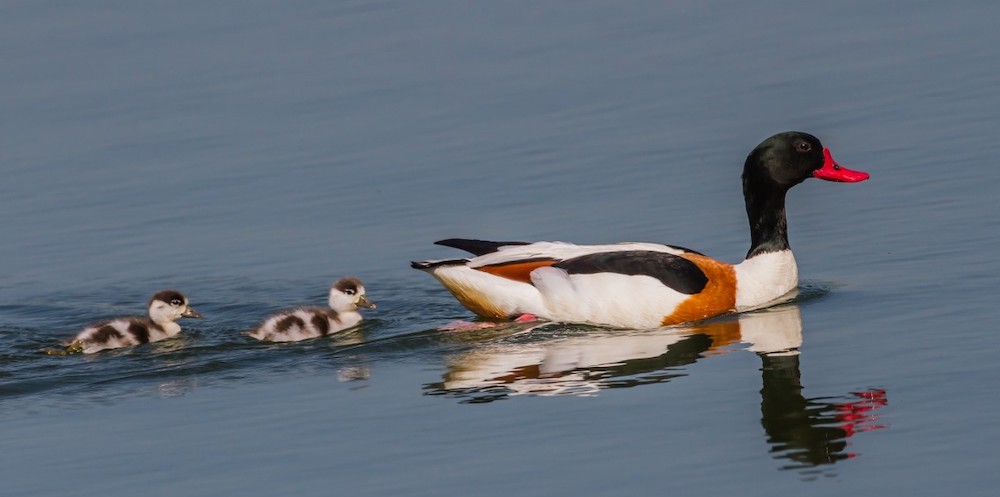61 Boring Birds: #47 Shelduck

Autumn is here, but I keep missing it. A small fleet of southward bound waders have made their way through in the last few weeks — whimbrels, black-tailed godit and, today, a little ringed plover — but I seem to be missing them all. And today and yesterday the first of the passerines that breed further north than London have stopped by, in the form of a willow warbler and a wheatear, but again I have been in the wrong place at the wrong time or — as seems likely with the wheatear this evening — merely looking in the wrong direction.
Birdwatching can be a frustrating hobby at times. Fishing is not about catching fish, say the wisest, zen fishermen, but birdwatching most definitely is about seeing birds. If a lack of enthusiasm in writing about the commonplace birds of the reserve has been evident lately, well now you know the reason why. I also injured my thumb somehow which… do not underestimate the affect a thumb in constant pain can have on your enjoyment of the simple pleaures in life. Particularly ones that involve repeatedly lifting something heavy, applying fine adjustments to it and then taking notes.
But despite these aggravations, the birds of E17 still bring warmth on this warmest of July days. A particularly tame egret stalked the shallows, with it long, white bootlace ponytail blowing in the light breeze like a comb-over gone astray in a gale. Its eyes and beak are a study in blue-grey ink and would make a good subject for a tattoo.
Speaking of eyes, in the evening sun the tufted ducks’ glow like yellow fire gems embeded in their glossy (but moulting matt) black heads. There is something sinister about the brightly coloured eyes of some of our diving ducks (most familiar ducks are however of the other type — the dabblers). The male pochard’s are demonic red, quite unlike the warm, dark occasionally white eye-shadowed eyes of the females. The female tufted duck shares the male’s hypnotic yellow irises though. Their ever so young new black ducklings must be terrified.
As if in anticipation of a repeat spot in the blog, and wanting to perform a little more for the camera, I see the same grebe family as yesterday, only this time both parents carry a chick each on their back. It looks like they’re gearing up for the parent-child race at a school sports day. Do such things still exist?
A little further along a female Shelduck stands guard on a log sticking out of the water. Behind her, stacked along the incline of another log leaning at a shallower angle, sit seven ducklings all in a row, and all of slightly different sizes, like an unpacked Russian doll. On the water a further ten ducklings — though some now not so easy to distinguish from the moulting female that tends to them — dabble, up-end and dive for whatever weeds and molluscs that feeds their growing bodies.
It’s not uncommon for shelducks to combine thier broods into more manageable creches, and the same is true of a number of other species of duck. The relative indepence of the duckling straight out of the egg (compare this with the blind, naked state of many songbirds), and the relative safety from predators of being waterborne probably lends itself well to this strategy.
Most interesting of all, watching these ducklings grow up, is to see them diving so regularly. Adult shelducks are birds of mudflats and saltmarshes, strutting about with their proud, red beaked, bottle green golf club heads held high, bending to sift the mud and brackish water for morsels of food. But as ducklings they are consumate divers. Though I can’t see how deep they get, I have to assume they reach the bottom of the lake to feed on the weeds. It’s remarkable that there’s such a regressive transformation of behaviour going into adulthood. Losing the ability to dive, which seems like an inherently useful thing for a duck to be able to do, is mind boggling failure to achieve their potential.
In a life or death situation would an adult shelduck still dive? It’d be unethical to test this out, sure, but it’d be interesting though, wouldn’t it.
I might apply for funding.
🦅 First boring bird
Related boring birds: Little egret, Tufted duck, Pochard, Great crested grebe,
🦚 All boring birds
Yaffle